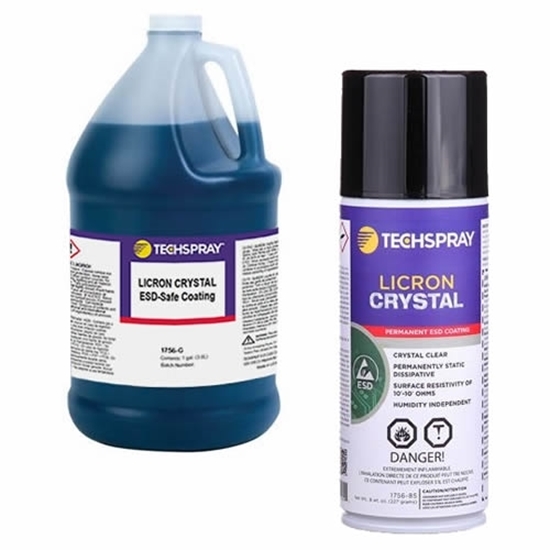
Licron Crystal ESD Safe Coating

Your Sample Request
Licron Crystal ESD Safe Coating
*=required field
TDS
Request SDS
Licron Crystal ESD Safe Coating
*=required field
FAQ's
The EDS-safe properties don’t fade over time. The only thing they have to worry about is wear-and-tear on the surface. If a walking surface, I would recommend a floor coating instead. If a working surface, I would suggest putting and ESD-safe mat over the Licron Crystal coated surface. Licron Crystal is not chemically resistant, so the mat becomes very important if we are cleaning with a solvent like IPA and dripping it all over the place. If it is a surface out of reach, so it doesn’t get abused, I would recommend they check the resistivity every month, if it is critical, or every 3 months if less critical. If the resistivity hasn’t changed, they can leave it alone. How often they will have to reapply depends on the environment. If a clean environment, they can wipe down with water and make it last for a very long time – years even. If in a greasy, sooty environment, they will have to clean with some kind of cleaning agent, which can degrade the coating. This will require more frequent reapplication.
It may be different state-by-state, so contact your state environmental agency for regional specific regulations. For a general guideline, here is the process according to EPA hazardous waste regulations 40CFR. The can has to be brought to or approach atmospheric pressure to render the can empty. Puncturing is not required, only that it “approach atmospheric pressure”, i.e. empty the can contents until it’s no longer pressurized. This insures that as much contents as is reasonably possible are out of the can. It is then considered “RCRA-empty”. At that point it can be handled as any other waste metal container, generally as scrap metal under the recycling rules. Note that the can is still considered a solid waste at this point (not necessarily hazardous waste).
Yes, HDPE (plastic) drums are designed to accept commonly available 2” threaded spigots / spouts. Spigots are available at distributors, like at https://www.grainger.com/product/GRAINGER-APPROVED-Drum-Tap-6PFN4.
Yes, the hole in the center of the cap is designed to work with commonly available 2” threaded spigots / spouts. To use: 1) remove the cap, 2) drill a large hole in the center of the threaded hole in the cap, 3) screw the spigot onto the cap, 4) screw the cap back on the carboy, 5) turn the carboy on its side so the spigot points down and check to make sure the spigot isn’t leaking. Spigots are available at distributors, like at https://www.grainger.com/product/GRAINGER-APPROVED-Drum-Tap-6PFN4.
There is a ratcheted ring on the bottom of the cap, which locks the cap into place and prevents it from unscrewing during shipment. To remove, insert a flathead screwdriver between the cap and the ring and pry it loose so the perforations break free. Then remove the ring. It is similar to removing the tamper-proof lock on a plastic jug of milk.
The shelf life of a product can be found on either the technical data sheet (TDS), available on the product page, or by looking on the certificate on conformance (COC). The COC can be downloaded by going to https://www.techspray.com/coc. Once you have the shelf life, you will need to add it to the manufacture date for a use-by date. The manufacture date can be identified by the batch number. The batch code used on most of our products are manufacture dates in the Julian Date format. The format is YYDDD, where YY = year, DDD = day. For example, 19200 translates to the 200th day of 2019, or July 19, 2019. This webpage explains and provides charts to help interpret our batch numbers: https://www.techspray.com/batch-codes.
Licron Crystal is being used to turn a plexiglass divider into an ESD-safe divider. A common question is how to disinfect from pothogens like SARS-COV-2 (coronavirus -- the virus that causes COVID-19) without degrading the static dissipative properties? 1) Avoid alcohol-based cleaners, because they can break-down Licron, especially with repeated use. Stay with Clorox types of disinfectants, and other similar cleaners. 2) Avoid wiping dry, which can abrade and wear off the coating. Either allow the disinfectant to air dry, or blot dry with a non-abbrasive wipe material. Paper towels can be rough because they are cellulose based. A soft material like microfiber (e.g. part #2368-2) or polyester knit wipe (part #2355-100) would be preferable. 3) Check coating integrity with a risistivity meter once the cleaner has dried. If resistance increased above acceptable range, reapply Licron Crystal.



